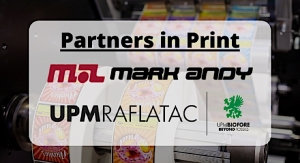Greg Hrinya, Associate Editor11.03.15
Digital Printing Think Tank featured three panel discussions and a keynote presentation from Jeffrey Hayzlett, former chief marketing officer at Eastman Kodak and a judge on the television show, The Apprentice. Sponsors included Advanced Print Technologies, Canon, Heidelberg, HP, Konica Minolta, Pantone, Ricoh and more.
The event’s speakers focused on how they shifted to digital from more traditional print methods, and how this evolving technology can optimize sales in the marketplace. For the first panel discussion, the industry experts explored the benefits of digital printing, which include a standardized setup, a streamlined process, higher efficiency and minimized human touch points.
“Most of the people that come to us need a job done fast,” said Ron Sizemore, owner of Influence Graphics. “A lot of what we do is short run, but as presses get faster and faster, there was a limit at what we used to consider a short run, that we could handle. That is kind of expanding now. … For us, automation is also really important.”
“One of the real values of digital printing is the personalization capabilities,” said Glen Boehmer, CEO of Sentinel Printing. “We also do quite a bit of variable data because every job seeks out a device that it’s best to be produced on.”
With advancements in inkjet printing and variable data printing (VDP), digital is expected to be the dominant print technology by 2030. It is expected to impact markets featured short runs, sheetfed and production web inkjet, as well as labels, packaging, wide format and others.
According to a Smithers Pira report, “The Future of Digital vs. Analog Printing to 2020,” digital printing accounts for 13.9% of all print and printed packaging in value and 2.5% of total world volume. Digital production is expected to be 17.4% of value and 3.4% of volume in 2020. Inkjet presses and workflow technology have played a large role in the technological increase, which has been evidenced by Heidelberg’s decision to compete in the space.
“We’ve realized that we need to make major investments in new software for the front end and also adding additional programmers, because the shift now is not necessarily the technical stuff on the press but also the programming of how we customize and build projects for customers that are going to meet their needs,” explained Nick Patrissi, national director of marketing and business development at Trend Offset Printing. “A lot more of that is going into the digital platform than ever had to go into standard presses.”
The speakers conceded, however, that digital printing is not the end-all, be-all in the printing industry. Different jobs require different methods, especially when factoring in run lengths and customization. In fact, the second panel discussion, titled, “Market Your Digital Printing Capabilities and Make Money,” covered the benefits of marrying complementing technologies. Hybrid presses have the ability to capture the best of both worlds like offset and digital or flexo and digital.
Speakers from Heidelberg, Konica Minolta, Kodak and Canon, to name a few, engaged in a discussion on inkjet printing versus toner-based technologies. According to Gavin Jordan Smith, vice president, Solutions and Production Planning, BIS at Konica Minolta Business Solutions USA, the current inkjet printing quality rivals that of toner. Other benefits involved printing on multiple substrates, online and offline finishing capabilities, and the ability to drive VDP.
Color management, finishing, prepress software and paper were all highlighted in the final panel discussion, which looked at ancillary technologies in the digital printing realm. “Offset has its own beautiful way of looking–since I’m 30 years in the printing industry–and digital is getting there,” said Kim Malkovich, director of Product Application at VITS International. “It’s getting closer and closer, but it’s in the eyes of the beholder. We’re helping that transition; it isn’t easy, but it’s getting there.”
The event concluded with a digital printing vendor fair and tabletop exhibition, designed to provide an opportunity for networking and follow-up questions. Printing Industries Alliance also announced its presence at drupa 2016. drupa is scheduled to run from May 31 to June 10, 2016 in Dusseldorf, Germany. The event will cover inkjet printing, as well as packaging production, 3-D printing, multi-channel and sustainability. Printing Industries Alliance will host scheduled VIP exhibit tours with many of the same sponsors from Digital Printing Think Tank.



























